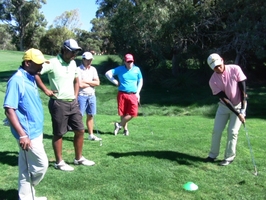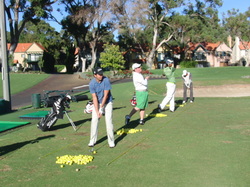 There’s something really interesting that happens to dedicated, serious golfers as they go about developing and improving their game. At some point of time many reach a stage of progress sometimes described as “arrested development” where they essentially reach an impasse with their golf performances and stop improving. This level has been described many ways by sports coaches such as; plateauing, leveling out, or becoming stale etc. Every time you come off the golf course after completing a round, your golf scores reflect your aptitude and attitude for creating your golf score. For many golfers it becomes more of a physical and psychological battle than a round of golf with their golf game taking control of them leaving them defeated, frustrated and unhappy. I think it’s one of the most fascinating aspects of golf performance psychology because it doesn’t seem to matter what improvement strategy the golfer takes, they discover yet another way to produce less than desirable scores. In-fact over the years I have met golfers who have been in this frustrating and unsettling place for literally years.  Golfer’s that reach this arrested development level will quite often change their equipment, change their golf instructor or even change their sport in an effort to change this condition. Quite often a change in equipment or instructor might do the trick but I have found that the problem has a lot more to do with how you go about improving your game rather than simply changing a brand of golf club. The way many advanced golfers practice tends to be based mostly on improving the golf swing performance to improve their golf scores which ends up being the limiting factor in improving their performances on the golf course. It’s like saying that the tyres on a racing car is the only factor that determines whether the driver will win the race or not, without considering all the other performance factors in the race car, like fuel for instance. Tyre's are very important on a racing car but they won’t do you much good if you run out of fuel before the end of the race.  So determining exactly what you need to work on to improve your golf scores should be you starting point. If you were going to practice your golf skills on the practice range for five hours what skills would get the most attention? In other words, how much time would you allocate to each skill set and why? Study the skill sets below and rate each skill set in order of its importance to you right now in improving your golf scores on the golf course. Consider the makeup of your round and determine which skills have the greatest effect on your golf scores.
When you go about improving your golf skills you need to know whether the skills that you’re focusing on will actually make a difference to your bottom line golf score. It’s not uncommon for advanced golfers to be working on the wrong golf skills, particularly when they’re in the arrested development phase.  You need to find a simple way to measure your golf skill routine to determine which of the golf skills need more of your focus. It’s not unusual to hear a golfer describe themselves as a bad putter, but is the golfer a bad putter because they are missing putts that are outside of the makeable range? What is the makeable range? Well, you will discover when you test your putting skills that you will make a high percentage of the putts you attempt from 3 feet (85 - 95%) of the hole and almost half as many from six feet (45 - 55%) of the hole and almost half as many again from ten feet (15 - 25%) of the hole and so on. So the question you might need to ask yourself is this; “am I a bad putter because I’m trying to hole my putts for par from outside ten feet of the hole because I don’t realise that from this distance I would actually only make 15 to 25 percent (1 to 2 out of 10) of them?” Should the question really be re-framed to something like this; “what percentage of my chip and pitch shots around the green finish within six feet of the hole?” I bet you that if you get a high percentage of your chip and pitch shots within six feet of the hole that you will make more putts and your putting average will improve. This illustration is the same for other skills as well.  If you consider yourself a bad driver of the ball and you hit say 40 percent or less of the fairways that you attempt to hit when you use a driver, is it possible that by testing your driver skill on the driving range to a set of targets that are placed twenty yards apart at 200 yards that you achieve a forty percent success rate (4 out of 10 shots) with a driver and a sixty five percent success rate when you use a three wood, however when you set the targets on the range at twenty five yards apart you now can achieve sixty percent success rate with your driver. So whenever you play a hole that has a fairway twenty yards wide at your driving distance you will take a three wood from the tee instead of your driver. If the fairway is twenty five yards wide you can confidently take your driver and swing away confidently. By measuring your different skill sets in this manner you can accurately determine which skills need more of your attention and which need less. Every golfer uses a formula for producing their golf scores and by measuring the elements that make up your golf score you can change the formula so that you break free from your arrested development and go on to produce better and more consistent rounds of golf. Lawrie Montague and David Milne - Pro Tour Golf College The Professional Golf Tour Training College If you are seriously considering joining our next semester at Pro Tour Golf College then contact us now at [email protected] if you are. You won't regret it. Comments are closed.
|
Archives
June 2019
|
Proudly Supported By
Copyright © 2011 - 2018 Pro Tour Golf College
Website Managed By Golf Performance Media
All Rights Reserved
Website Managed By Golf Performance Media
All Rights Reserved



 RSS Feed
RSS Feed



